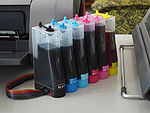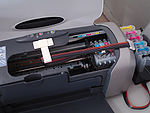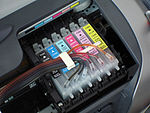| Revision as of 07:31, 24 April 2007 editSmackBot (talk | contribs)3,734,324 editsm Date/fix the maintenance tags or gen fixes← Previous edit | Revision as of 18:32, 11 May 2007 edit undo72.129.85.179 (talk)No edit summaryNext edit → | ||
| Line 8: | Line 8: | ||
| CIS is also known as bulk ink. | CIS is also known as bulk ink. | ||
| The inkjet printer industry has viewed continuous flow systems as a threat to profits from sale of ink cartridges, while high volume users demand lower cost ink{{Fact|date=March 2007}}. The result has been an arms race - the manufacturers have changed ink formulae, smart chips, printer & cartridge models so frequently that the CIS suppliers have had difficulty keeping up{{Fact|date=March 2007}}. Recently CIS manufacturing has shifted from a "one of a kind - customization" cottage industry to higher volume mass market production as Chinese engineers realized the market potential{{Fact|date=March 2007}}. The result has been a significant reduction in pricing of a CIS{{Fact|date=March 2007}}. System prices have dropped from the $500 range to less than $100 |
The inkjet printer industry has viewed continuous flow systems as a threat to profits from sale of ink cartridges, while high volume users demand lower cost ink{{Fact|date=March 2007}}. The result has been an arms race - the manufacturers have changed ink formulae, smart chips, printer & cartridge models so frequently that the CIS suppliers have had difficulty keeping up{{Fact|date=March 2007}}. Recently CIS manufacturing has shifted from a "one of a kind - customization" cottage industry to higher volume mass market production as Chinese engineers realized the market potential{{Fact|date=March 2007}}. The result has been a significant reduction in pricing of a CIS{{Fact|date=March 2007}}. System prices have dropped from the $500 range to less than $100. | ||
| To avoid the need to remove the cartridge and reset the smart chip every time the chip thinks the cartridge has run out of ink, CIS often reverse engineer the smart chip and build a custom version that automatically resets itself{{Fact|date=March 2007}}. Software drivers for the printer may balk at these third party chips and workarounds are sometimes required{{Fact|date=March 2007}}. | To avoid the need to remove the cartridge and reset the smart chip every time the chip thinks the cartridge has run out of ink, CIS often reverse engineer the smart chip and build a custom version that automatically resets itself{{Fact|date=March 2007}}. Software drivers for the printer may balk at these third party chips and workarounds are sometimes required{{Fact|date=March 2007}}. | ||
Revision as of 18:32, 11 May 2007
| Template:Wikify is deprecated. Please use a more specific cleanup template as listed in the documentation. |



A Continuous Ink System (CIS) is a cost-effective replacement for ink-jet printer cartridges. In contrast to conventional cartridges, a CIS uses very large (about 100ml/color) ink tanks, which are connected with tubes to the printhead nozzles. The tanks can be conveniently refilled from an ink bottle - there is no need for syringes.
CIS is also known as bulk ink.
The inkjet printer industry has viewed continuous flow systems as a threat to profits from sale of ink cartridges, while high volume users demand lower cost ink. The result has been an arms race - the manufacturers have changed ink formulae, smart chips, printer & cartridge models so frequently that the CIS suppliers have had difficulty keeping up. Recently CIS manufacturing has shifted from a "one of a kind - customization" cottage industry to higher volume mass market production as Chinese engineers realized the market potential. The result has been a significant reduction in pricing of a CIS. System prices have dropped from the $500 range to less than $100.
To avoid the need to remove the cartridge and reset the smart chip every time the chip thinks the cartridge has run out of ink, CIS often reverse engineer the smart chip and build a custom version that automatically resets itself. Software drivers for the printer may balk at these third party chips and workarounds are sometimes required.
One major feature of a CIS isn't just in savings from reduced demand for ink cartridges, it is in the ability to use special inks.
This computer hardware article is a stub. You can help Misplaced Pages by expanding it. |